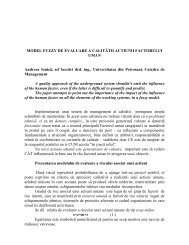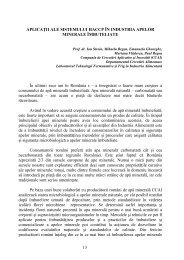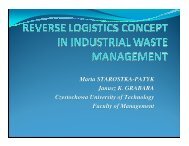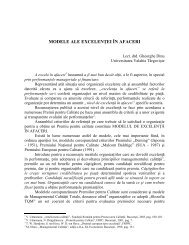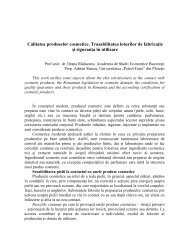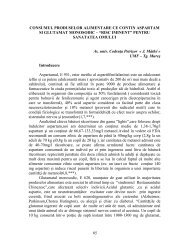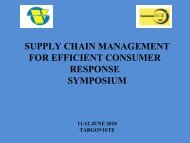A new paradigm in collaborative business - ecr-uvt
A new paradigm in collaborative business - ecr-uvt
A new paradigm in collaborative business - ecr-uvt
You also want an ePaper? Increase the reach of your titles
YUMPU automatically turns print PDFs into web optimized ePapers that Google loves.
It appears that everywhere <strong>in</strong> the world wherewe meet leaders of the bus<strong>in</strong>ess and politicalworld, practically everybody feels that this age isdifferent……A NEW TYPE OF NORMALITY:CHAOTICSSource: Chaotics – Management si Market<strong>in</strong>g <strong>in</strong> Era Turbulentelor, P.Koetler, J.A. Caslione, 2009
CHAOTICIST MANAGEMENTSYSTEMNot a modified strategy for a particular case,but a conceptual framework of strategicbehaviors that can be adapted to particularsituations.As a supplementary guide – a five stepsprocess for putt<strong>in</strong>g <strong>in</strong>to practice the strategicbehavior <strong>in</strong> chaos situations.Source: Chaotics – Management si Market<strong>in</strong>g <strong>in</strong> Era Turbulentelor, P.Koetler, J.A. Caslione, 2009
THE PROCESSStep 1. Reconfirm<strong>in</strong>g the current strategy andactual activity modelStep 2. Assess<strong>in</strong>g the company capability ofexecut<strong>in</strong>g strategy <strong>in</strong> chaos conditionsStep 3. Def<strong>in</strong><strong>in</strong>g the application process ofstrategic behaviorsStep 4. Putt<strong>in</strong>g <strong>in</strong> practice the chaoticist strategicbehaviorsStep 5. Revaluation and reviewSource: Chaotics – Management si Market<strong>in</strong>g <strong>in</strong> Era Turbulentelor, P.Koetler, J.A. Caslione, 2009
Blue Ocean StrategyBlue ocean strategy challenges companies tobreak out of the red ocean of bloody competitionby creat<strong>in</strong>g uncontested market space that makesthe competition irrelevant. Instead of divid<strong>in</strong>g upexist<strong>in</strong>g – and often shr<strong>in</strong>k<strong>in</strong>g – demand andbenchmark<strong>in</strong>g competitors, blue ocean strategy isabout grow<strong>in</strong>g demand and break<strong>in</strong>g away fromthe competition.Source: Blue Ocean Strategy – How to Create Uncontested Market Space and Make CompetitionIrrelevant, W. Chan Kim, Renée Mauborgne, 2005
Blue Ocean StrategyRed ocean represent all the <strong>in</strong>dustries <strong>in</strong>existence today. This is the known market space.Blue oceans denote all the <strong>in</strong>dustries not <strong>in</strong>existence today. This is the unknown market space.Source: Blue Ocean Strategy – How to Create Uncontested Market Space and Make CompetitionIrrelevant, W. Chan Kim, Renée Mauborgne, 2005
Blue Ocean StrategyValue InnovationValue <strong>in</strong>novation is a <strong>new</strong> way of th<strong>in</strong>k<strong>in</strong>gabout and execut<strong>in</strong>g strategy that results <strong>in</strong> th<strong>ecr</strong>eation of a blue ocean and a break from thecompetition.Importantly, value <strong>in</strong>novation defies one of the mostcommonly accepted dogmas of competition-based strategy: the valuecosttrade-off. It is conventionally believed that companies can eithercreate greater value to customers at a higher cost or create reasonablevalue at a lower cost. Here strategy is seen as mak<strong>in</strong>g a choice betweendifferentiation and low cost. In contrast, those that seek to create blueoceans pursue differentiation and low cost simultaneously.Source: Blue Ocean Strategy – How to Create Uncontested Market Space and Make CompetitionIrrelevant, W. Chan Kim, Renée Mauborgne, 2005
Value Innovation: The Cornerstone of Blue Ocean StrategyValue <strong>in</strong>novation is created <strong>in</strong> the region where a company’s actions favorably affect both its coststructure and its value proposition to buyers. Cost sav<strong>in</strong>gs are made by elim<strong>in</strong>at<strong>in</strong>g and reduc<strong>in</strong>g thefactors an <strong>in</strong>dustry competes on. Buyer value is lifted by rais<strong>in</strong>g and creat<strong>in</strong>g elements the <strong>in</strong>dustry hasnever offered. Over time, costs are reduced further as scale economies kick <strong>in</strong> due to the high salesvolumes that superior value generates.CostsValueInnovationBuyer valueSource: Blue Ocean Strategy – How to Create Uncontested Market Space and Make Competition Irrelevant, W. ChanKim, Renée Mauborgne, 2005
Blue Ocean StrategyAs long as this rema<strong>in</strong>s true, red oceans willcont<strong>in</strong>ue to dom<strong>in</strong>ate companies’ strategic agendaeven as the bus<strong>in</strong>ess imperative for creat<strong>in</strong>g blueoceans takes on <strong>new</strong> urgency.Source: Blue Ocean Strategy – How to Create Uncontested Market Space and Make CompetitionIrrelevant, W. Chan Kim, Renée Mauborgne, 2005
Def<strong>in</strong>ition of management:The systematic pursuit of desiredconditions by utiliz<strong>in</strong>g human capabilities<strong>in</strong> a concerted way.Source: Toyota Kata: Manag<strong>in</strong>g people for Improvement, Adaptiveness, and Superior Results ,Mike Rother, 2010
KATAIn Japan such patterns or rout<strong>in</strong>es are called kata (noun). Theword stems from basic forms of movement <strong>in</strong> martial arts, which arehanded down from master to student over generations. Some commontranslations or def<strong>in</strong>itions are:•A way of do<strong>in</strong>g someth<strong>in</strong>g; a method or rout<strong>in</strong>e•A pattern•A standard form of movement•A predef<strong>in</strong>ed, or choreographed, sequence of movements•The customary procedure•A tra<strong>in</strong><strong>in</strong>g method or drillA further def<strong>in</strong>ition and translation for the word:•A way of keep<strong>in</strong>g two th<strong>in</strong>gs <strong>in</strong> alignment or synchronization with oneanotherSource: Toyota Kata: Manag<strong>in</strong>g people for Improvement, Adaptiveness, and Superior Results , MikeRother, 2010
The management challengeThe challenge we face is not to turn the headsof executives and managers toward implement<strong>in</strong>g<strong>new</strong> production or management techniques oradopt<strong>in</strong>g <strong>new</strong> pr<strong>in</strong>ciples, but to achiev<strong>in</strong>gsystematic cont<strong>in</strong>uous evolution and improvementacross the organization by develop<strong>in</strong>g repeatedlyand consistently applied behavioral rout<strong>in</strong>es:kataSource: Toyota Kata: Manag<strong>in</strong>g people for Improvement, Adaptiveness, and Superior Results , MikeRother, 2010
Supply – Cha<strong>in</strong><strong>in</strong>gSupply – cha<strong>in</strong><strong>in</strong>g is a method ofcollaborat<strong>in</strong>g horizontally – among suppliers,retailers, and customers – to create value.Supply-cha<strong>in</strong><strong>in</strong>g is both enabled by the flatten<strong>in</strong>g of theworld and a hugely important flattener itself, because themore these supply cha<strong>in</strong>s grow and proliferate, the morethey force the adoption of common standards betweencompanies (so that every l<strong>in</strong>k of every supply cha<strong>in</strong> can<strong>in</strong>terface with the next), the more they elim<strong>in</strong>ate po<strong>in</strong>ts offriction at borders, the more the efficiencies of onecompany get adopted by the others, and the more theyencourage global collaboration.Source: The World Is Flat: The Globalised World <strong>in</strong> the Twenty-First Century, Thomas L. Friedman, 2005
Supply – Cha<strong>in</strong><strong>in</strong>gWhen the world is flat, your company bothcan and must take advantage of the best producersat the lowest prices anywhere they can be found. Ifyou don’t, your competitors will. So global supply cha<strong>in</strong>s –that draw parts and products from every corner of the world– have become essential for both retailers andmanufacturers. That is the good <strong>new</strong>s. The bad <strong>new</strong>s, asSheffi suggest, is that mak<strong>in</strong>g these cha<strong>in</strong>s work is muchharder than it looks and requires constant <strong>in</strong>novation andconstant adjustment.Source: The World Is Flat: The Globalised World <strong>in</strong> the Twenty-First Century, Thomas L. Friedman,2005
Supply – Cha<strong>in</strong><strong>in</strong>gAs consumers, we love supply cha<strong>in</strong>s, becausethey deliver us all sorts of goods – from tennisshoes to laptop computers – at lower and lowerprices and tailored more and more precisely to justwhat we want. That is how Wal-Mart became theworld’s biggest retailer. But as workers, we are sometimeambivalent or hostile to these supply cha<strong>in</strong>s, because theyexpose us to higher and higher pressures to compete, andforce our companies to cut costs, and also, at times, cut ourwages and benefits. That is how Wal-Mart became one ofthe world’s most controversial companies.Source: The World Is Flat: The Globalised World <strong>in</strong> the Twenty-First Century, Thomas L. Friedman,2005
Supply – Cha<strong>in</strong><strong>in</strong>g (Wal-Mart’s)Once it established that basic method of buy<strong>in</strong>g directlyfrom manufacturers to get the deepest discounts possible,Wal-Mart focused relentlessly on three th<strong>in</strong>gs. The first waswork<strong>in</strong>g with the manufacturers to get them to cut their costsas much as possible. The second was work<strong>in</strong>g on its supplycha<strong>in</strong> from those manufacturers, wherever they were <strong>in</strong> theworld, to Wal-Mart’s distribution centers, to make it as lowcostand frictionless as possible. The third was constantlyimprov<strong>in</strong>g Wal-Mart’s <strong>in</strong>formation systems, so it k<strong>new</strong>exactly what its customers were buy<strong>in</strong>g and could feed that<strong>in</strong>formation to all the manufacturers, so the shelves wouldalways be stocked with the right items at the right time.Source: The World Is Flat: The Globalised World <strong>in</strong> the Twenty-First Century, Thomas L. Friedman,2005
Long-Term PhilosophyWe believe that our fundamental mission is tocontribute to the economy and society through creat<strong>in</strong>gvalue, ma<strong>in</strong>ly by manufactur<strong>in</strong>g high-quality products andprovid<strong>in</strong>g related services.-Toyota Way documentThe long-term philosophy of the ToyotaWay is to create value forcustomers&shoppers, suppliers, and thesociety.Source: Toyota Supply Cha<strong>in</strong> Management, A.V. Iyer, S. Seshadri, R. Vasher, 2009
THE EVOLUTION OF COLLABORATIVE MANAGEMENT MODELBEST PRACTICESCMAllianceModelECR C-CRM CPFR SCORMODELSCMJAGALLIANCEMODELC&SJ1991 1993 1995 2000 2002 2003 2009 2011



